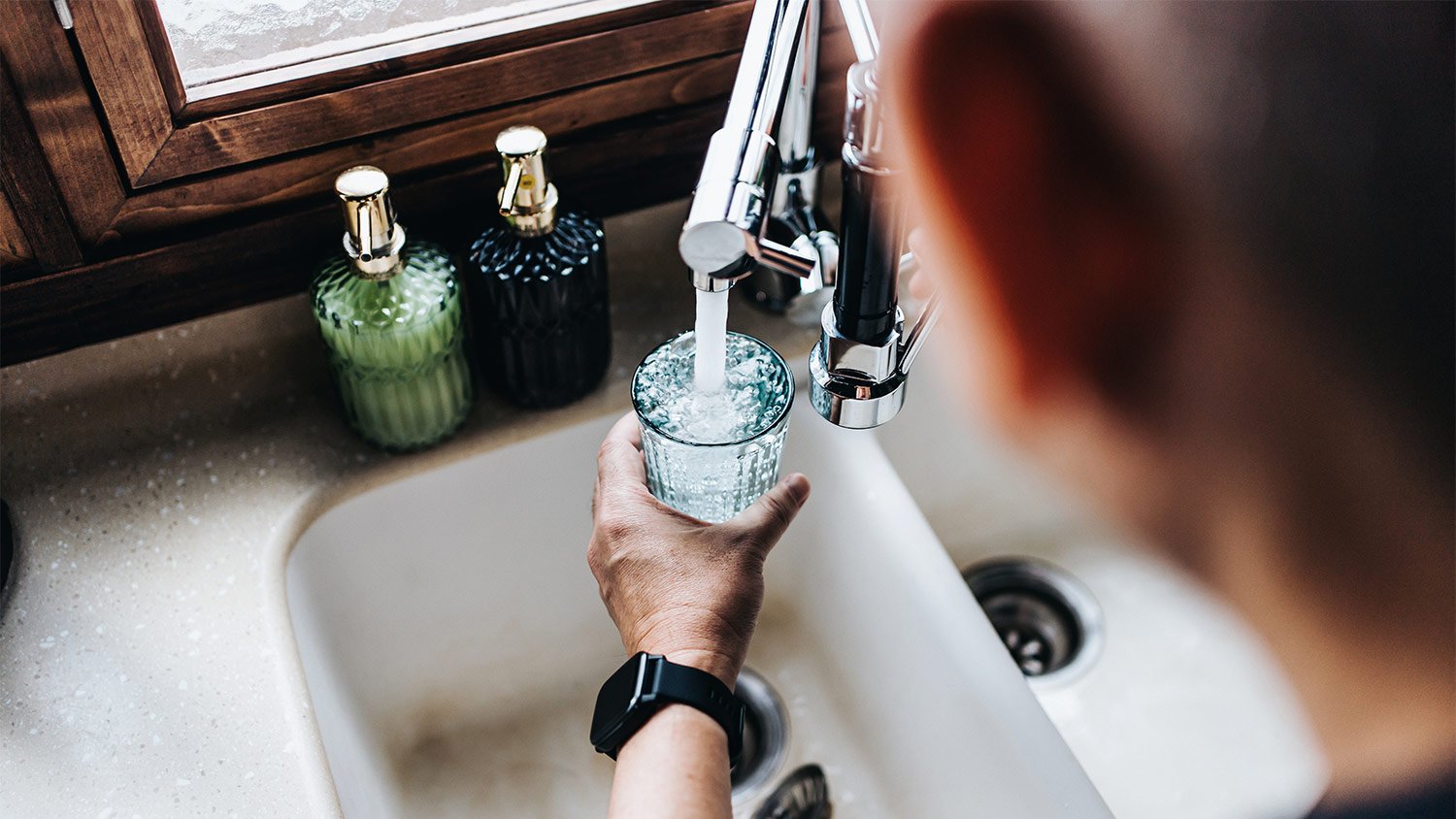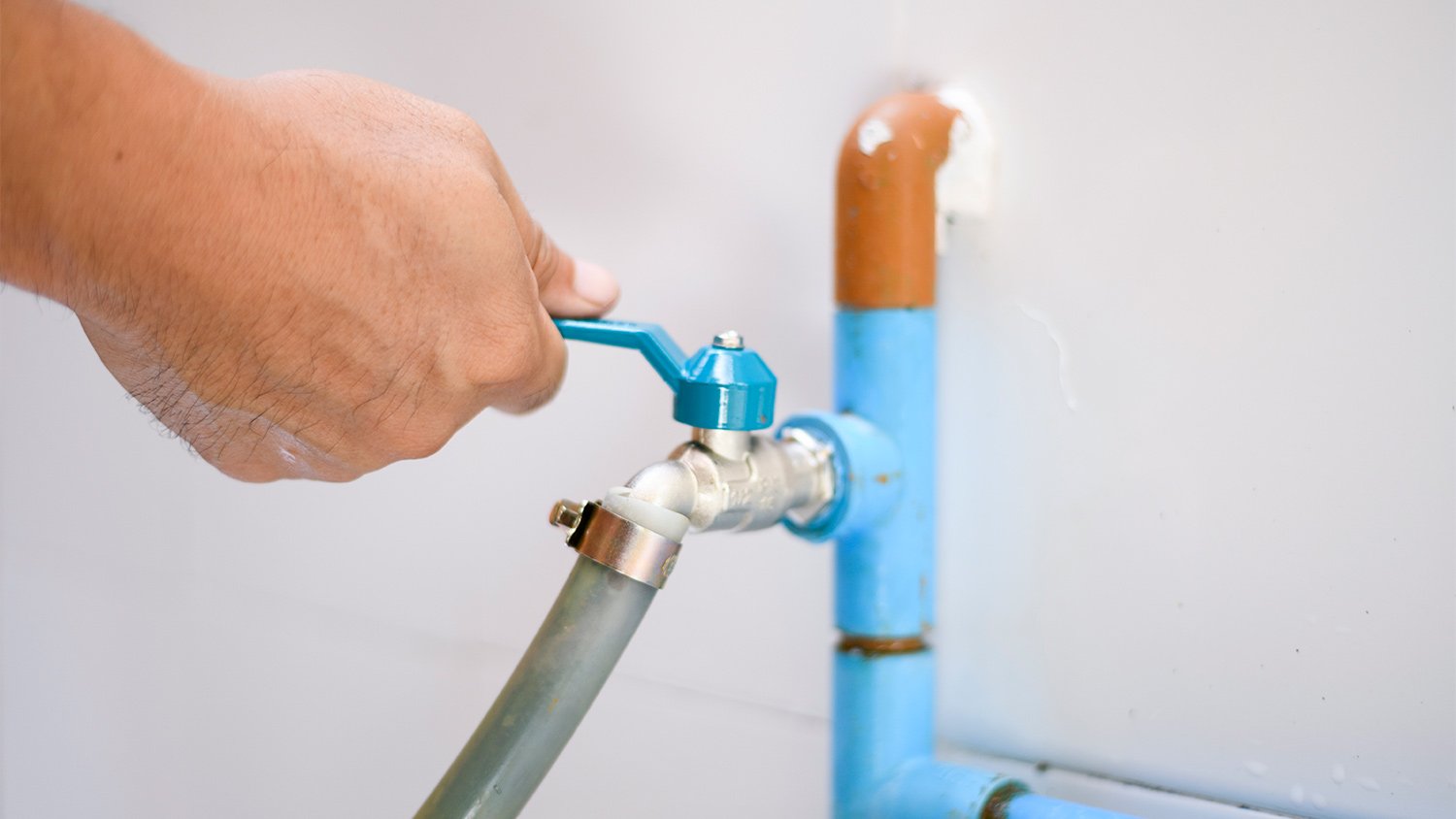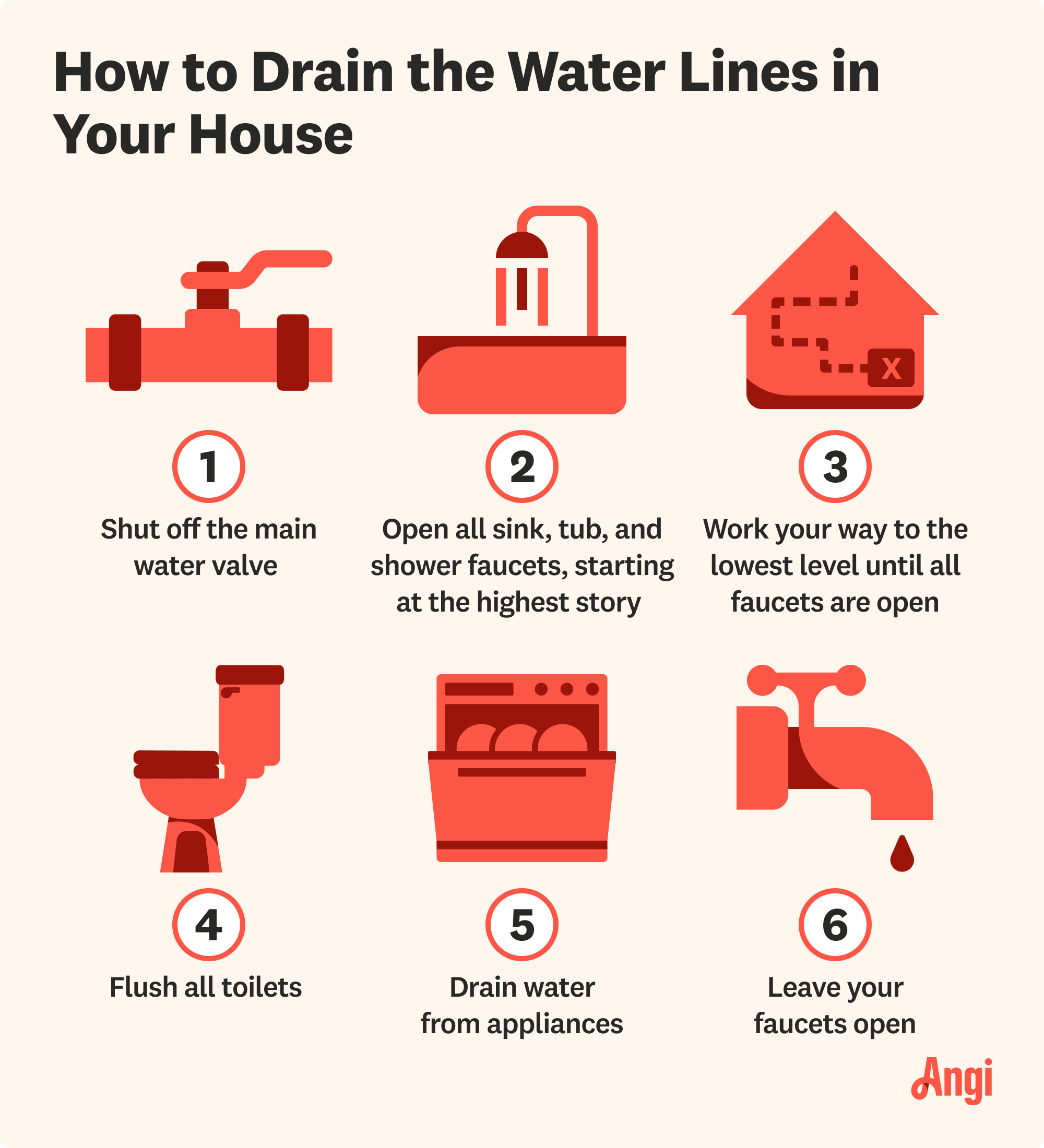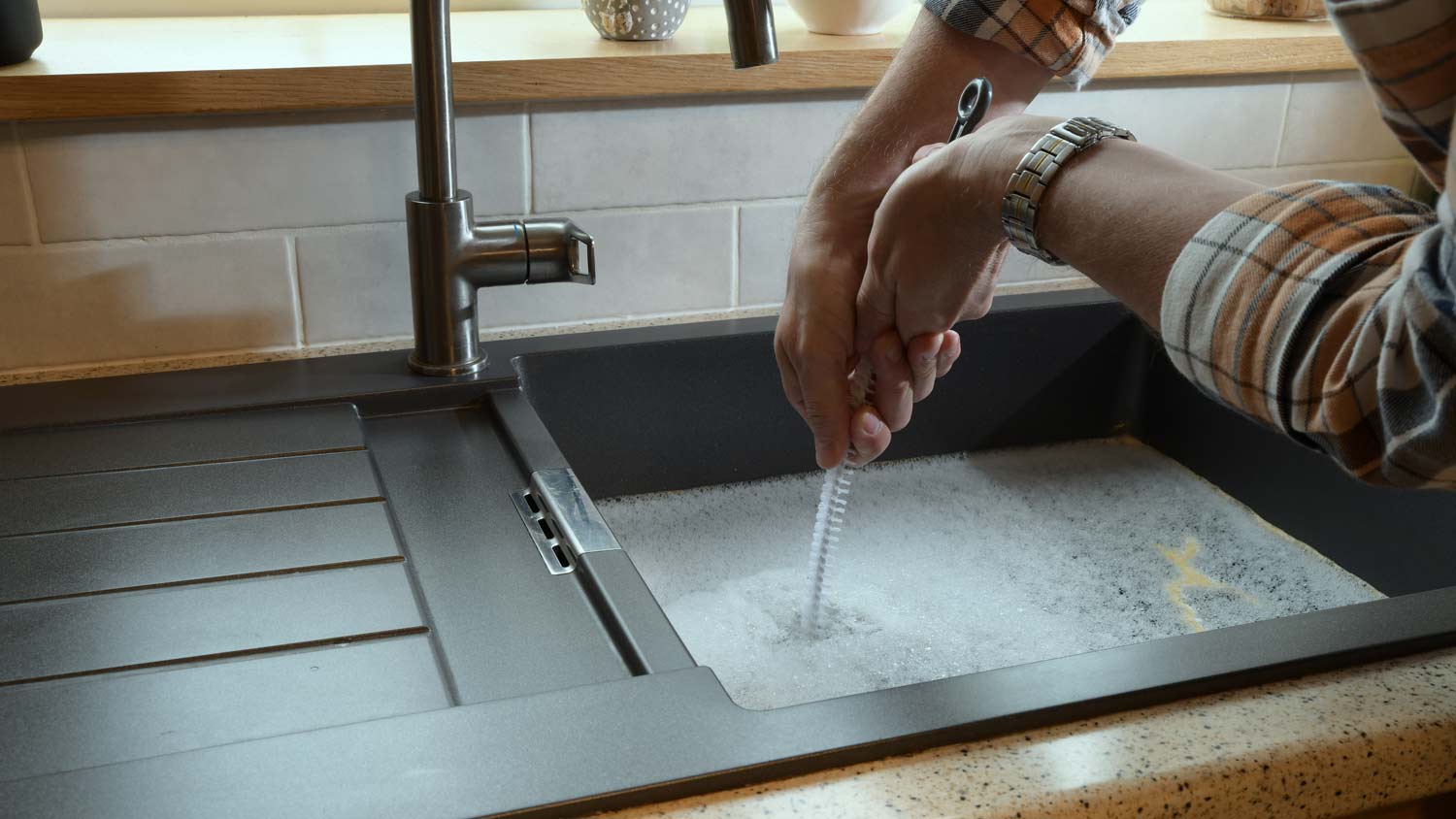How Do I Drain the Water Lines in My House? A Guide to Draining Your Plumbing System
Plumbing DIYs can be draining, but this one is a cinch


Most homeowners will rarely encounter the need to drain their home’s water lines. If the situation does arise, whether you need to make plumbing repairs or prep for freezing temperatures, it’s good to know what you’re doing. This step-by-step guide will walk you through how to drain the water lines in your house and how to fill them back up.
Why Do I Need to Drain the Water Lines in My House?
Though it’s a good idea to know where your main water shut-off valve is in case there’s an emergency like a burst pipe, there are only a few situations where you’ll need to drain the line:
Plumbing repairs: If you’re making major plumbing repairs, you may need to drain the entire line or the part of the system that needs the repair. This is common during plumbing additions and pipe replacements.
Upgrading your plumbing: If you’re upgrading your plumbing, you’ll need to drain the impacted pipes and reservoirs in fixtures or appliances (like your toilet tank or water heater) to prevent water damage.
Freeze protection: Draining your water lines is an essential step to winterizing your plumbing if you’re preparing for freezing temperatures or leaving your property unattended for a period of time and don’t want to risk a frozen pipe.
Water hammer: A water hammer, also known as a hydraulic shock, is a wave of pressure that happens when water suddenly changes direction. This can be caused by a number of things like air in the pipes or water pressure issues. It manifests as a sudden stop of water or a loud bang as you turn your faucets on and off. Draining the line and charging it with water can introduce a pocket of air that acts as a cushion and eases the sudden change in pressure.
How Much Does It Cost to Drain Water Lines?
A plumber will wrap the cost of draining your water line into the total cost of your plumbing repair. For example, replacing a main water line costs $650 to $2,900, while repairing the water line costs $400 to $1,700. Both could require draining the line prior to starting the job.
How to Find the Main Water Shut-Off Valve

Before you can drain the water lines in your house, you’ll need to find your main water shut-off valve. This valve looks like a lever (a ball valve) or a wheel-shaped handle (a gate valve) attached to a pipe. It will be larger than the other valves within your home’s plumbing. The location depends on the type of foundation you have:
Slab foundation: Locate your water heater and look for the valve underneath it or near the top of it. It may be hidden behind an access panel.
Basement: Find where the water supply line enters your home. This is usually where your outdoor hose connects to the piping on the exterior of your house. The valve is directly opposite the hose on the interior wall of your basement.
Crawl space: The main shut-off valve is somewhere along the front wall of the foundation where the main water supply enters the home. You may find it in your basement, near the water heater, or under the kitchen sink.
Pier and beam: Look for the valve where the main water supply enters the home. With this type of foundation, the shut-off valve will be under your home in a utility area or in your basement.
If you can’t find the shut-off valve inside your home, there is a possibility it’s located in an outdoor ground-level utility box facing the street. In this case, you’ll need to contact the utility company’s emergency helpline. Their number will be written on the box, and they’ll give you instructions on how to turn off the water or send a team to do it for you.
How to Drain the Water Lines in Your House

Draining your water lines can take anywhere from 30 minutes to a few hours depending on the size of your home. Luckily, it only requires a few minutes of your time and the patience to let it drain. Follow these steps to drain the water lines in your house.
Turn Off the Main Shut-Off Valve
Start by turning off the main water supply using the shut-off valve. If you have a ball valve, turn it to the off position by moving the lever 90 degrees to the right. If you have a gate valve, turn the knob until the flow of water is completely blocked (you’ll turn it clockwise to turn it off and counterclockwise to turn it back on).
Open Your Faucets
Next, open all the faucets in your home. Go room by room, starting at the top of the house and making your way down to the basement. Make sure you open all sink, bathtub, and shower faucets. Don’t forget faucets in utility rooms or laundry rooms, like laundry tub spigots.
Flush the Toilets
Flush all the toilets in your home until the tanks are completely empty. You may have to flush them repeatedly.
Drain Water From Appliances
If you have other fixtures or appliances that hold water, you’ll need to drain them, too. This could include a water heater, dishwasher, hose spigot, outdoor sink, or washing machine. If you don’t already know how to do this, read the owner’s manuals for instructions.
Leave Faucets Open
Keep your faucets open until you’re ready to turn your water back on. This lets air escape and prevents the pipes from forming a vacuum that can damage your plumbing.
How to Refill Your Water Lines After Draining
When you’re ready to turn your water back on, you’ll need to charge the pipes (fill the pipes) back up with water. Follow these steps:
Close your faucets: Start with the basement faucets and work your way up.
Turn on the water supply: Go back to the main shut-off valve and turn it to the on position. You’ll know the water is on because you’ll hear it flow from behind the pipe.
Open your faucets: Start opening your faucets one by one to allow the water to flow. Water may sputter and initially come out discolored, but it should resolve in a few minutes.
Flush your toilets: Flush your toilets several times in a row to fill the bowls and tanks.
Refill appliances: If you have other appliances that hold water like a water heater, read the owner’s manual for guidance on how to fill the tanks.
Turn off the faucets: Once your water is flowing normally, you can turn off the faucets.
Tips for Draining Your Water Lines
These simple plumbing maintenance tips can help you drain your water lines with confidence:
Open the shut-off valve slowly: When you plan to turn your water back on, start by opening the shut-off valve slowly. Only open it halfway. Wait to hear the system fill (you should hear the sound of rushing water, which will quiet once the system fills) before opening it all the way. This protects the aging parts of your system.
Slightly close the gate valves: Older gate valves have a tendency to get stuck open. To prevent this, once you turn the valve to open it, turn the handle to close it about one-quarter of the way. This will allow water through, but prevent the valve doesn’t lock in place.
Consider blocking drains and toilet bowls: If you’re draining your lines because you’re leaving your home for an extended period of time, the standing water in drains can evaporate and allow sewer gas to leech into your home. Consider blocking off drains and toilets using plastic wrap or wadded-up cloths.
Soak up the extra: If you’re winterizing your home, don’t just drain the water supply lines. Unless you plan on setting your thermostat to a minimum of 55 degrees Fahrenheit, you should also soak up standing water in traps and toilets. Standing water can freeze and crack traps or porcelain fixtures.
DIY vs. Hiring a Pro
Draining your water lines is a simple task that only takes a few minutes of effort if you can locate your main water shut-off valve. You can do it yourself, or call a local plumber if it’s out of your comfort zone. However, most of the time, you’ll only need to drain your lines when there’s a problem (like resolving a blockage) or if you’re renovating (like adding a new bathroom)—which both involve significant plumbing work that isn’t something you can take on yourself.
If you’re draining the line to winterize your pipes or flushing out a water hammer, you could save money by tackling this project on your own (though you’ll want to hire a pro if you hit a snag and your lines won’t drain properly). If you’re draining the line because you have to repair or install plumbing, hire a pro from the start. The average plumbing repair costs $200 to $500, and hiring a plumber means you won’t risk making a DIY mistake and accidentally causing serious water damage.
Frequently Asked Questions
It’s a good idea to drain your pipes to prevent them from freezing if you’re expecting extremely cold temperatures or planning to be away from your home for an extended period of time during the winter. You may be able to avoid draining your pipes if you insulate outdoor pipes and keep your home heated to a minimum temperature of 55 degrees.
It can take anywhere from 30 minutes to a few hours to drain the water lines in a house. Larger homes or homes with more complex systems will take more time, while smaller homes with a single bathroom and fewer appliances will take less time. Turning off the water and opening all the faucets should only take a few minutes to half an hour, but the rest of the job is time spent waiting for the water to drain.















